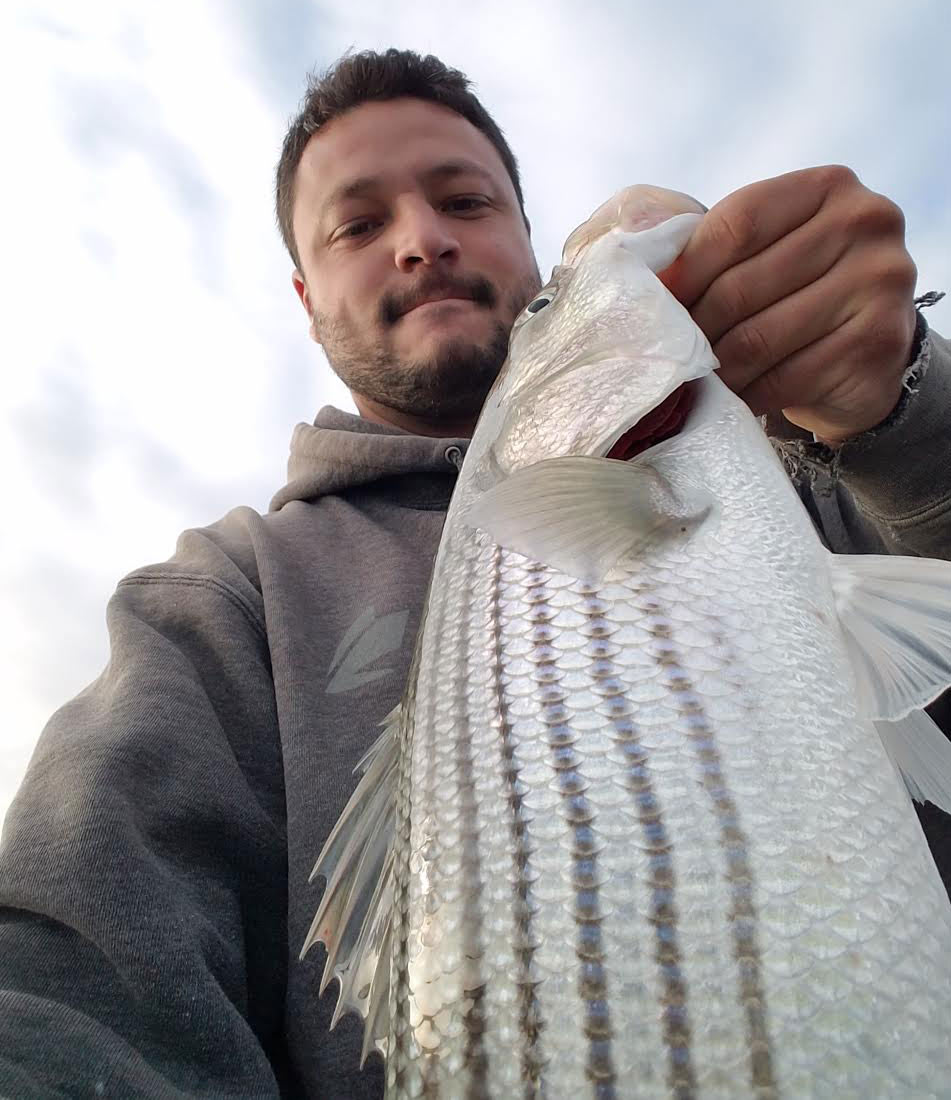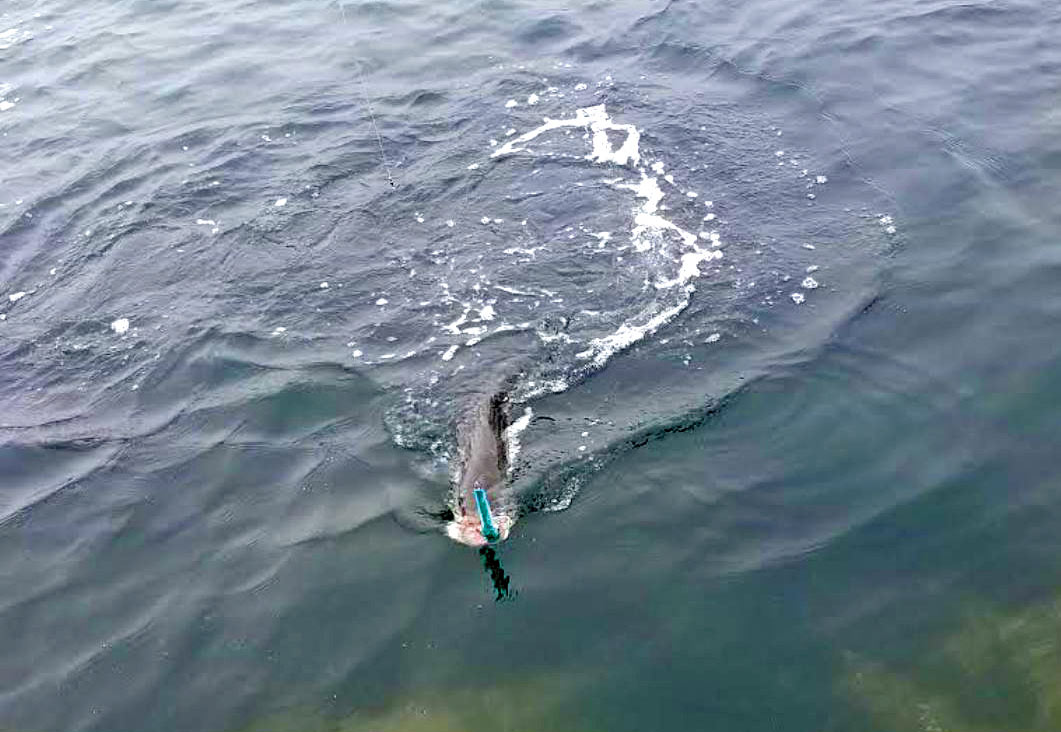
Changing your normal approach to the fishing game can make a big difference in the outcome of your next fishing trip.
Sometimes paying attention to the little things – even those subtle nuances of your buddy’s successful cast and retrieve routine – is what’s needed to finish your session in the surf on a high note.
A strange thing happened to me a few seasons ago. One night while striper fishing with a close friend of mine we managed to find some fish in one of my go-to spots. Throwing swimmers we both managed three or four fish each before the bite slowed down to a painfully sluggish pick. Determined to get us back into the thick of things I opted to start switching lures while my friend Scott stuck with the swimmer. Scott quickly started hooking up, which prompted me to go back to the swimmer I was using before. Being that I had the exact same lure he was throwing in my bag, it was a no brainer to clip it on again. Much to my surprise however, I couldn’t buy a bite while Scott had a fish on seemingly every cast.
No matter what I did, for some reason I could not get anything to commit. Scott (now feeling bad) even instructed me to cast to the exact same spot he was getting bass after bass in. After failing in that attempt I took a seat to watch helplessly as he continued to school me. Eventually when my nerves calmed a bit I started to realize what he was doing that I wasn’t. Once his lure came across the rip line in front of us, he gave it a twitch and then allowed it to pause for a second or two. As if on cue, his rod would double over the minute he began his retrieve. I, on the other hand, was working the same lure through the same water on a steady retrieve without pausing, therefore at best I would get nothing more than a bump every few casts or so. With nothing left to lose I decided to stop the lure just as Scott had done and wouldn’t you know it, my rod finally doubled over too.
Since that session, I have experimented extensively by paying more attention to the little things. Sometimes adding or subtracting from your routine is what it takes to figure it out, and it’s always really cool when your day goes from being fishless to a successful one. Let’s face it, fish (especially stripers) have probably seen a lure or two come across their path, therefore it’s always a good idea to mix it up when they get picky. Finding your rhythm is the key to your success and it’ll without a doubt give you an edge when a spot gets crowded. Whether from surf or boat, adding a little variety is a good thing.
Change Is the Key
Much like that session with my friend Scott, the little details that day made a huge difference and I have a theory as to why. If you ever get the chance to see stripers feeding actively on any type of bait no matter what it is, you’ll probably notice something that holds true each time it happens. When bait gets nervous, it doesn’t swim in a straight path, and it sometimes pauses or even darts in opposite directions to throw off the predator chasing it. I only bring this up because think of those types of scenarios when you fish lures such as swimmers or topwater plugs.
I have often found that breaking up the cadence or rhythm in my retrieve has resulted in more interest from stripers when they weren’t responding well to my offerings. Next time you head out, take a second and pay attention to how you normally retrieve a lure after a few casts. I bet you’ll notice that most, if not all of your retrieves, repeat themselves cast after cast. We can easily fall into the habit of making repeated casts using the same retrieve with little or no variation. While this approach can catch fish, I’ve found that more times than not, adding some variety in your retrieve far out produces the same method used over and over again.

As I stated before, I’m willing to bet most of the stripers that swim through our waters have come across a lure or two in their lifetime. Sometimes mixing it up is what it’ll take to get a response out of those fish. Don’t believe me? The next time you’re catching fish and the bite slows down, try incorporating various twitches or pauses in your lure before switching it up to see if it makes a difference. This past spring, I was enjoying a session of catching schoolie bass at sunup on pencil poppers. With the tide setting up I thought the bite was just going to get better and better but the opposite ended up happening, and the fish shut off. After not hooking up for nearly 40 minutes I decided to pause my pencil popper mid retrieve, and the lure was greeted with an immediate explosion. Several more fish fell to the same retrieve before out of curiosity, I went back to my standard retrieve for a few casts. Those casts produced nothing, while the next cast with a pause produced another fish.
The point here is that the way you work your retrieve makes a huge difference in how many fish you catch for the day. Experiment with your retrieve and let the fish tell you what they like. Sometimes it’s a big detail, other times it’s very subtle, but you won’t know if you don’t take the time to experiment.
Size & Speed
In my plug bag I always like to carry at least two sizes of my favorite lures and for good reason. I’ve found that when bass get picky, they really can be stubborn and sometimes the actual profile of a bait makes a huge difference. For some reason when the fish are keyed into a certain type of bait, they can become extremely frustrating to catch. When this happens, if you don’t have what they want, you might as well go home. One remedy to this is I always carry two sizes of my most-fished lures, especially if I know what the fish are feeding on. Obviously there’s no reason to bring an entire tackle store out with you, but having options focused on the dominant baitfish certainly can’t hurt. Popup scenarios always come without warning such as fish being just out of reach, or fish keying into small bait even though you’ve matched the hatch with what’s swimming in the water. Also, if you find yourself always reaching for a certain lure, chances are you’re not only confident in its ability to work, but have gotten good at fishing with it as well. Having options when it comes to reaching for your go-to lure will always give you an edge when a pattern or conditions change.
Now that we’ve looked at spicing things up a bit on both inside and outside of your tackle bag, it would definitely be worth mentioning the speed you fish your lures. If there is one constant theme when it comes to fishing with lures, it is how fast or slow I fish them. Take for instance a night I had two years ago. I was wading a back bay flat on a very dark night with little wind, and tossing floating swimmers for actively feeding bass. I normally fish these lures very slowly on such nights and this was setting up to be a good one as I picked three bass at the start of the tide. The bite shut down rather quickly somewhere near the middle of the tide and knowing the spot well, I knew the fish didn’t just disappear. Having confidence that I had the right lure matched with the bait these bass were feeding on, I went against my normal routine and decided to speed up my retrieve. Three casts later, a fish hit my plug so hard the rod was nearly yanked from my hands. From that point on I caught fish until the tide ran out. Speeding up my retrieve was the difference between having a subpar night and an outstanding one.

Obviously speeding up or slowing down your lure might not be the underlying factor to your success on any given day or night, but the object is to try something different when the going gets tough. Take careful notice when a bite slows down or is non-existent to begin with. When you are confident the fish are there, experimenting with retrieval speeds may be worth a quick check before digging back into your bag to try something else.
Don’t Always Settle
It is always important to pay attention toyour surroundings since sometimes things aren’t always exactly what they seem. Take for instance a night I had on the beach few falls ago with the same friend Scott, who gave me the schooling mentioned earlier.It was a chilly, late fall night as we arrived at a fishy looking piece of water after driving the beach for over two hours. Within a few casts it became very apparent that this spot was stacked with 21- to 25-inch bass lined up in the trough in front of a sandbar. That fall sandeels had been dominating the surf soI instinctively reached for my favorite sand eel imitation. I was into fish at a fast pace and things were shaping up well. After an hour or so of having my fun with the chunky schoolies in front of me, I happened to glance over at Scott who was down the beach a ways. I noticed his rod doubled over, and it quickly became apparent that he was into a good fish as he dragged a teen size bass into the wash. Not five minutes later, I again saw Scott hooked up, and this time he beached a fish of around 20 pounds.
Since we had walked far enough away from each other, I didn’t have the motivation to walk all the way back just to ask what he was doing when I myself was catching fish as well. Still figuring he was fishing a sandeel pattern I continued to catch schoolies at will and it wasn’t until I saw two or three more fish over 15 pounds landed that I became very curious. As it turned out, the smaller fish that night were feeding heavily on sandeels while bigger bass, mainly fish in the upper teens to mid-20s, were feeding on shad that were also present. Scott noticed the bigger bait and on a hunch threw the biggest plug in his bag, which made all the difference in the world to the bigger fish. By the time I realized what was happening and made the switch, it was already too late. None of my fish exceeded 28 inches, while Scott easily had a dozen fish 15 pounds or better.
Always be aware of your surroundings even when you are catching fish. I’m not suggesting leaving fish to go find bigger fish that may not be present, but always keep in the back of your mind the possibility of something better being available. This can be especially true when a spot with actively feeding bass has two or more types of bait presentas was the case that night on the beach.
By tweaking your normal routine and going against the grain, the results will more often than not speak for themselves. Whether you’re like me and are always looking for something new, or perhaps you’re just getting bored of the same old routine day in and day out, try marching to the beat of a different drum. Finding your own rhythm is fun, and when it works, it will be like music to your ears.



